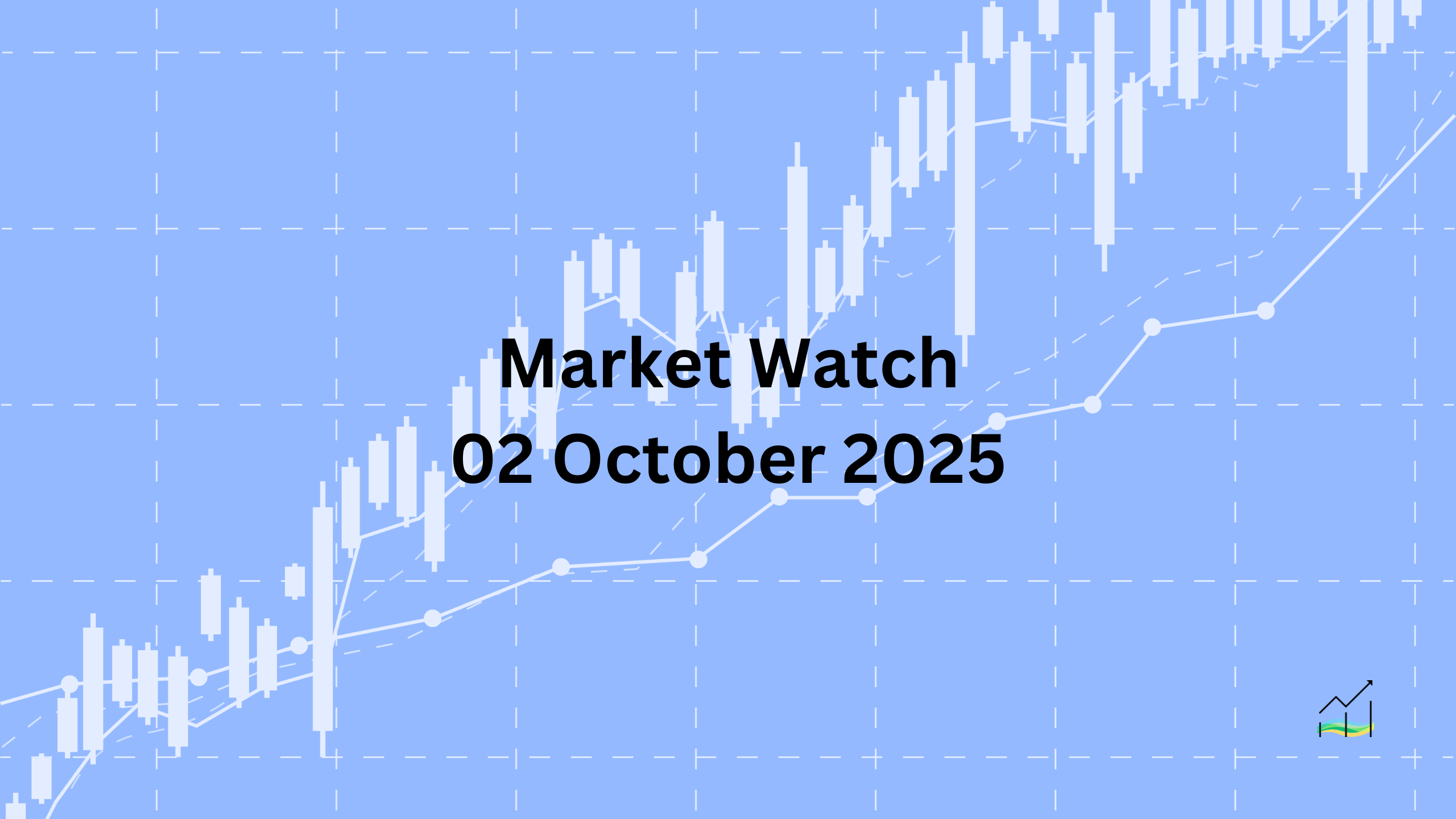02/10/2025 Market Watch

Dollar Softens as Risk Sentiment Lifts Equities
Key Takeaways:
- Dollar trades softer near session lows with light news and US government shutdown ongoing.
- Canadian dollar lags among G10 while most emerging market currencies strengthen.
- Equities mostly higher with Europe’s Stoxx 600 up for a fifth straight day.
- US Treasury yields hold near mid-range with 10-year just under 4.10%.
- Oil steady with November WTI around $61.50.
The US dollar is trading weaker in late European turnover as a lack of major headlines and the ongoing partial US government shutdown weigh on sentiment. Most major and emerging market currencies are firmer against the greenback, though the Canadian dollar remains an underperformer among G10 peers.
Equity markets show a positive tone. Japan was mixed, but nearly all other markets outside of China, which remains shut for holidays, advanced. Europe’s Stoxx 600 index rose by about 0.75% after yesterday’s 1.15% jump, marking a fifth consecutive gain. US equity futures are also trading higher, building on yesterday’s close that overcame early shutdown concerns.
Bond markets show slight easing in yields. Most European 10-year benchmarks are softer, with the UK Gilt yield a small exception. The US 10-year Treasury yield is holding a little below 4.10%, close to the middle of its recent trading range.
Oil prices remain stable, with November WTI crude near $61.50. It has not traded significantly lower since testing $61 in early September.
United States of America
Overview
The Dollar Index remains under pressure, trading softly above the 50% retracement level near 97.40. It has now posted four consecutive declines, matching the longest losing streak since June, and market sentiment is weak. The 61.8% retracement level is slightly below 97.15, leaving the dollar vulnerable to further downside.
Labour market data added to the bearish tone. The ADP private sector employment estimate signalled job losses for the second straight month and the third time this year, with a downward revision to August’s figures. ADP noted that much of September’s weakness stemmed from a recalibration with Bureau of Labor Statistics benchmarks, which shaved 43k jobs from the headline, though this does not explain the August downgrade.
Manufacturing signals remain mixed. The final PMI held at 52.0, unchanged from the preliminary reading. The ISM manufacturing index rose slightly to 49.1 from 48.7 but has remained below the 50 contraction threshold since February. Prices paid eased from 63.7 to 61.9 but remain elevated, highlighting ongoing inflationary pressures. Employment improved to 45.3 from 43.8 but is still in contraction. Meanwhile, new orders slipped back below 50, falling to 48.9 after briefly moving above the expansion threshold in August.
Economic Drivers
- Dollar Index weakness tied to labour market concerns and softer sentiment.
- Consecutive ADP private sector job losses raise expectations of another Fed rate cut.
- Benchmarking adjustments with BLS data highlighted as a driver of headline ADP volatility.
- Manufacturing sector shows ongoing contraction, with new orders slipping below 50 again.
- Inflationary pressures persist with prices paid remaining high, though pace is easing.
Data and Events
- 02 October 2025: Unemployment Claims
Price Action
- Dollar Index remains under 97.50, trading softly after four consecutive losses.
- Vulnerable to further downside if it tests the 61.8% retracement level near 97.15.
Key Points:
- Dollar Index weak and facing longest losing streak since June.
- ADP employment data showed back-to-back job losses, adding to rate cut expectations.
- Benchmarking adjustments skewed September data but do not explain August revision.
- ISM manufacturing index remains below 50, signalling ongoing contraction.
- Prices paid remain elevated, keeping inflation concerns in focus.
Australia
Overview
The Australian dollar has consolidated recent gains, holding above $0.6600 after recovering from last week’s lows near $0.6520. Despite attempts, it has struggled to break through $0.6625, a level tied to sizeable option expiries. Additional option expiries and retracement resistance near $0.6635 have created a ceiling, with last week’s high also capping momentum. Beyond that, the next hurdle is seen closer to $0.6665.
Australia’s August trade surplus came in significantly smaller than expected at A$1.83 billion, down sharply from A$5.4 billion a year earlier. The average surplus so far this year is around A$4.2 billion, compared with nearly A$6.0 billion over the same period in 2024. China remains Australia’s largest trading partner, accounting for more than trade with its next five partners combined. Imports from the US fell for the third straight month, underlining shifting trade dynamics.
On the domestic front, household spending slowed to 5.0% year-over-year in August, from a revised 5.3% in July. While still strong, it reflects a moderation that keeps the Reserve Bank of Australia cautious about further easing. The futures market does not fully price in another rate cut until late in the first quarter of 2026.
Economic Drivers
- Softer August trade surplus of A$1.83 billion, well below last year’s levels.
- Goods trade surplus averages A$4.2 billion in 2025, down from nearly A$6.0 billion in 2024.
- Heavy reliance on China as the main trading partner, larger than the next five combined.
- Imports from the US declined for a third consecutive month.
- Household spending growth slowed to 5.0% year-over-year, moderating from July.
- Cautious RBA stance, with markets not expecting another rate cut until late Q1 2026.
Data and Events
- 02 October 2025: Goods Trade Balance
- 02 September 2025: Household Spending
- 02 September 2025: RBA Financial Stability Review
Price Action
- Australian dollar consolidating above $0.6600 after recovery from last week’s lows.
- Resistance near $0.6625 tied to option expiries and retracement levels around $0.6635.
- Next resistance seen near $0.6665 if current levels are cleared.
Key Points:
- Australian dollar consolidates gains, capped by resistance at $0.6625–0.6635.
- August trade surplus shrank sharply to A$1.83 billion, well below 2024 levels.
- Household spending growth slowed but remains elevated.
- RBA cautious on policy easing, with futures not pricing another cut until Q1 2026.
- Trade dependence on China remains dominant, while US imports continue to fall.
Europe
Overview
The euro has moved closer to, but not surpassed, the 50% retracement level of its losses since the Federal Reserve’s recent rate cut, positioned slightly above $1.1780. Heavy option expiries totaling nearly 3 billion euros at $1.1785 and $1.1790 today have acted as a cap on upward momentum. Beyond that, resistance lies at the 61.8% retracement and last week’s highs near $1.1815.
On the rate front, the US two-year yield premium over Germany has narrowed for a fourth consecutive session. After bottoming near 150 basis points before the Fed’s decision, it rose back to just above 162 basis points last week before easing again. Yesterday’s drop of more than six basis points was the sharpest in over a month, leaving the spread slightly above 153 basis points today.
Macroeconomic conditions remain mixed. The eurozone unemployment rate held steady at 6.3% in August, consistent with the region’s average since last year, following July’s 6.2% reading which matched the lowest level since the creation of the monetary union. In Switzerland, EU-harmonized consumer prices fell 0.3% in September, leaving the year-over-year rate at zero. Inflation briefly dipped negative in May. Despite the Swiss National Bank’s deposit rate sitting at zero, government bond yields remain negative out to five years.
Economic Drivers
- Eurozone unemployment stable at 6.3% in August, near historic lows.
- US-Germany two-year yield spread narrowed for a fourth session, signaling relative shifts in rate expectations.
- Significant option expiries limiting euro’s upside momentum.
- Switzerland reported flat inflation in September, with negative yields persisting out to five years.
Data and Events
- 02 October 2025: Unemployment Rate
Price Action
- Euro capped below $1.1780 retracement, with option expiries reinforcing resistance.
- Further resistance lies near $1.1815 at the 61.8% retracement and last week’s highs.
Key Points:
- Euro unable to break above $1.1780 despite recent gains.
- Large option expiries at $1.1785 and $1.1790 weighing on upside.
- US-Germany yield spread narrowed to around 153 basis points.
- Eurozone unemployment stable near record lows at 6.3%.
- Swiss inflation flat, with bond yields negative out to five years.
Japan
Overview
The yen has strengthened as the US dollar continues to lose ground after testing JPY150 last week. The dollar has now fallen to around JPY146.60, the lowest since the Federal Reserve’s rate cut, and remains vulnerable. This retreat has erased nearly three-quarters of the rally that followed the Fed’s decision. The decline was accelerated by the weaker-than-expected ADP jobs report in the US and a corresponding drop in Treasury yields.
The yield gap between US and Japanese 10-year government bonds has narrowed to around 245 basis points, the smallest since April 2022. Earlier this year, the spread was as wide as 355 basis points in January, but recent moves highlight a sharp shift in relative rate expectations.
On the policy side, Bank of Japan Deputy Governor Uchida reiterated that an interest rate hike will follow if the economy and inflation evolve in line with the bank’s outlook. He referred to findings from the Tankan survey but avoided commenting on the recent downside surprises in industrial production and retail sales. Market pricing shows around a 63% probability of a rate hike later this month, rising to over 75% by year-end. Japan’s August labour market data and the final PMI release are due tomorrow.
Economic Drivers
- Yen strength tied to narrowing US-Japan yield spread, now at its lowest since April 2022.
- BOJ Deputy Governor Uchida reinforced the possibility of a rate hike if the outlook holds.
- Tankan survey cited as a supportive factor, while weaker industrial output and retail sales were overlooked.
- Market pricing signals a 63% chance of a hike in October, rising to over 75% by year-end.
Data and Events
- 02 October 2025: Consumer Confidence
Price Action
- Dollar fell to JPY146.60, the lowest since the Fed’s recent rate cut.
- Nearly three-quarters of the post-Fed rally has been retraced.
- Dollar remains under pressure, vulnerable to further declines if support near JPY146.60 breaks.
Key Points:
- Dollar weakened sharply against the yen, nearing JPY146.60.
- Yield spread between US and Japan narrowed to its tightest since April 2022.
- BOJ signals possible rate hike if conditions align with outlook.
- Market sees 63% chance of October hike, 75% before year-end.
© 2025 SKONE Enterprise (003319453-V). All rights reserved.
The content on this site is for informational purposes only and does not constitute financial advice.


